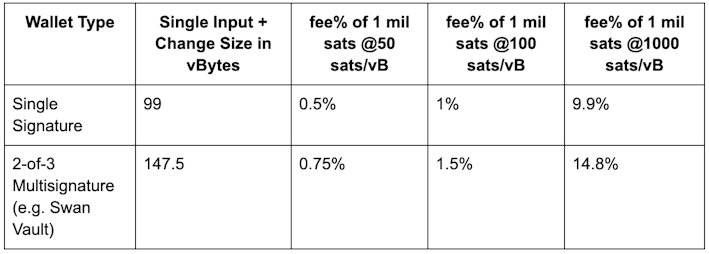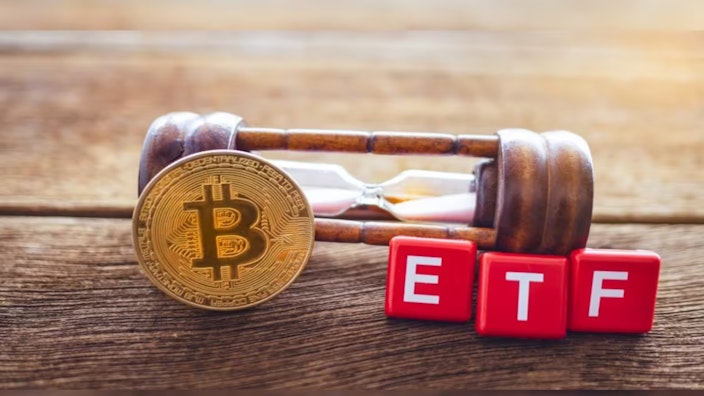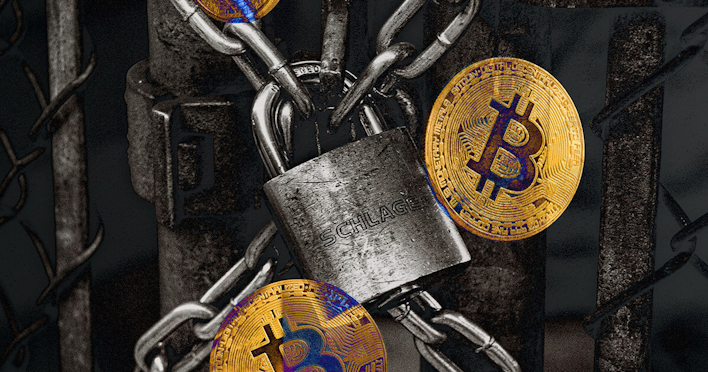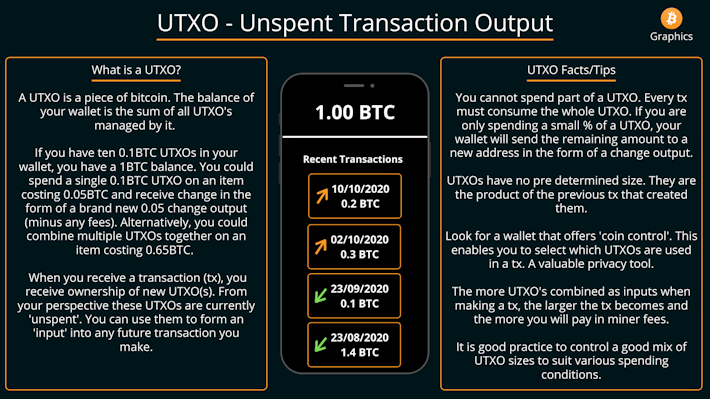Bitcoin Wallet UTXO Management
Imagine UTXOs as distinct bills within your wallet, each holding a unique value, similar to how you use different denominations of cash for a purchase. Learn more about UTXO’s below!…

Introduction — What’s are UTXOs
Why Do I Have to Manage Them
Like physical currency, which exists in bills and coins of different denominations, Bitcoin also exists in discrete chunks. Unlike physical currency, these chunks can be of any size. Every one of these Bitcoin chunks is the output of a transaction that uses other chunks as an input. We refer to the spendable chunks as unspent transaction outputs or UTXOs. Simply put, UTXOs are chunks of Bitcoin that can still be spent because they have not yet been spent.
When you receive on-chain Bitcoin, your wallet detects one or more new transaction outputs that it can spend and adds their amounts to your balance. When you send on-chain Bitcoin, your wallet selects one or more UTXOs from those you have previously received and uses them as inputs in a transaction, paying your intended recipient and returning any leftover amount back to you as a new UTXO (just like how you might get $5 back in change if you use a $20 bill to buy a $15 item).
The blockspace market
When you want to send a Bitcoin transaction, you have to get a miner to include your transaction in a block. You do this by paying them a transaction fee.
Bitcoin’s rules limit the size and "weight" of each block that miners create. Both size and weight refer to the amount of bytes of data they consume.
Because the amount of data permitted in a block is limited, miners pack in as many transactions as they can that pay the highest fee per byte. The more inputs and outputs a transaction has, the more data it uses. And the more people that are trying to transact at the same time, the higher the cost per byte gets. So a transaction with many inputs and outputs at a time when blockspace is in high demand can be many times more expensive to process than a transaction with a single UTXO as its input and one new UTXO as its output.

Bitcoin Whitepaper
Consolidation of UTXOs
Like taking physical coins to a coin counting machine and receiving a few bills in exchange, Bitcoin UTXOs can be consolidated to reduce future spending costs. Also, like coin conversion machines, it costs money to do this. Consolidation is worth doing in some cases, especially when fees are low, and your wallet contains many small UTXOs. Moreover, as Bitcoin becomes more popular, it is expected that the demand for on-chain space will lead to an increase in the cost per byte of data, thus making it wise to spend a little now to consolidate so as to save on future transactions.
Managing UTXOs
Every time you receive Bitcoin, it adds a UTXO to your wallet.
For most Bitcoin users, financial privacy is the main reason for having more than one UTXO in their wallet. When you spend a UTXO to make a payment, the recipient (and the whole Bitcoin network) sees the UTXO you used as the input. If you kept all your Bitcoin in one UTXO, you would show your total balance.
Similarly, if you receive Bitcoin through several separate services or people and then consolidate those UTXOs together, the parties you bought Bitcoin through can now tell that you have another source of Bitcoin and (if it’s a consolidation down to 1 UTXO) how much total bitcoin you have.
On the flip side, if your wallet contains too many UTXOs, you’ll find that making payments from that wallet costs more than if you were spending from fewer UTXOs with larger balances — sometimes prohibitively so. This is because most payments will be consuming 2 or more UTXOs, increasing the transaction size and fee.
You want to strike a balance of reducing the number of UTXOs in your wallet while protecting your privacy to a degree that you are comfortable with. If all of your Bitcoin comes from a single source, and you only withdraw back to that source, then a single UTXO is sufficient. If you make regular payments to third parties, having several UTXOs to avoid revealing your whole balance when making payments is advisable.
What’s the smallest UTXO I should have?
As discussed above, fewer and more valuable UTXOs are better, other than privacy concerns. Let’s consider some fee rates and wallet types and see what minimum UTXO sizes might be reasonable. The table below shows transaction sizes for different wallet types and the percentage of the UTXO that would be required to be spent if the UTXO were 1 million satoshis in value.

As you can see, if fees are at 50 sats/vB (satoshis per virtual byte) fees cost 0.5%-0.75% per transaction, but they increase proportionately with the fee rate, becoming 10%-15% if fees rise twentyfold to 1,000 sats/VB:
Historically, the highest-ever fee needed to be included in the next Bitcoin block, in satoshis per vbyte, was recorded in December of 2017 at approximately 1,100 sats/vB. At the time of writing, however, the next block fees range between 15 and 50 sats/vB. While we cannot be certain of the future dynamics of the market for Bitcoin block space, these historical data points can inform our UTXO size decisions.
For a single signature wallet that you expect to spend in the next few years, 1 million satoshis is an adequate minimum size. At 1 million satsoshis (₿0.01), you are very likely to be able to spend that UTXO and pay less than 1% to fees, especially if you are a bit patient.
If you are putting your Bitcoin away for years in cold storage in a multi-signature wallet such as Swan Vault, 1 million satoshis per UTXO is too small to ensure that the UTXO’s value won’t be materially reduced by future fees. The longer you expect to hold a UTXO, the larger it makes sense for it to be (up to a point). A starting point for a multi-signature wallet is 2 million satoshis (₿0.02) per UTXO, increasing to 5 million (₿0.05) if you expect to hold the UTXO for more than 5 years.
When you buy Bitcoin with Swan, set an automatic withdrawal threshold to get your Bitcoin into self-custody as soon as it makes sense for your future spending expectations.
Further information — avoiding on-chain fees with Lightning Network
Using Bitcoin’s lightning network, you can realize significant savings in your on-chain fees if you actively use Bitcoin. Opening a lightning channel is similar in cost to any other Bitcoin transaction. Once that channel is open, you can pay and receive Bitcoin many times. The more payments you make and receive while the channel is open, the lower your effective cost per payment can get.
Summary
UTXO management is a bit of a Goldilocks scenario — you want them not too big, not too small, but just right. Today, a good rule of thumb that should remain valid for a while is a minimum of one million satoshis in standard wallets and two to five million satoshis in multi-signature wallets, depending on how long you plan to leave them untouched.
If you plan to transact often and want to maintain maximum privacy, the lightning network is more suitable for the money you intend to spend.
You needn’t settle on only one of these solutions, either. You can keep your generational savings in the former and your short-term spending funds in the latter.
Swan IRA — Real Bitcoin, No Taxes*
Hold your IRA with the most trusted name in Bitcoin.
More from Swan Signal Blog
Thoughts on Bitcoin from the Swan team and friends.


Running the Numbers: How Fiat Pushed the American Dream Away from Millennials
By Sam Callahan
Bitcoin symbolizes hope for a generation who increasingly feel as though their futures have been stolen from them by the traditional fiat system.


Best Bitcoin ETF Fees: Lowest to Highest (May 2024)

By Matt Ruby
In this guide, we analyze and present the top 10 Bitcoin ETFs with the lowest fees for cost-effective investing.


Privacy, Executive Order 6102 & Bitcoin

By Steven Lubka
Let’s keep pushing forward for the future we want to see, one in which both the price of Bitcoin and global freedom can go up together.
